Fifth Week in Phnom Penh + Angkor Wat & Siem Reap
Five weeks already! It feels like just yesterday I stepped of the plane from Guangzhou, instantly dizzied by the Cambodian heat, my passport clutched in a white-knuckle grip. I can hardly believe that I am halfway done with my summer with ODC, but time really does fly. I am doing my best to enjoy the weeks I have left and get some productive work accomplished. Right now, I am working with Jean to draft ODC’s severance pay policy. Earlier this week, I prepared a presentation for the government on Cambodia’s copyright laws and policy, specifically on exceptions for educational materials. That ended up leading nicely into my project of updating ODC’s terms of services and disclaimer pages.
Everyday life in Phnom Penh continues to be a charming adventure. I am pleased to report that my Khmer is steadily improving. I can now order food, direct my tuk tuk drivers, and generally get around the city easily enough. Typically, I am rewarded with big smiles whenever I eke out a Khmer phrase, everyone eager to encourage my modest effort. That said, I still have a long way to go. My nonchalant comfort with the language is only surface deep and, usually, I can only maintain the façade for one or two sentences. Lately, one of my favorite “hobbies” has been casually asking about prices in Khmer, only to be caught bewildered when the shopkeeper gives me a quick answer in kind. Everything comes down to picking your battles. Sometimes, I try to soldier on in Khmer (often a labor for everyone involved). More often than not, however, I just swallow my pride, smile sheepishly, and repeat myself in English.
My bicycle rides have gone just as smoothly. While I easily mastered the art of walking through Phnom Penh traffic within a few days (read: it’s like playing Frogger but, you know, with higher stakes), biking through the city is a new challenge. I have never been particularly proficient with a bicycle, even when given every advantage. As such, I pretty much just teeter totter through traffic, wobbling unevenly around pot-holes and moving cars. I have definitely drawn a few looks from Khmer people that clearly seem to say, “Oh wow! She really can’t ride a bike! I can’t wait to see what happens next!” Luckily, however, I have managed to remain relatively unscathed. My dignity? Less so.
This past weekend, a group of us went to Siem Reap, the home of Angkor Wat. In all honesty, I have been dreading writing this blog post. I just feel completely overwhelmed by it, as though I could easily fill a novella with my scant two-day adventure. To give you an idea of the staggering amount of ground we covered, below is the list of temples we visited, all within two laborious mornings:
- Angkor Wat
- Angkor Tom
- Bayon
- Baphuon
- Phimeanakas
- Terrace of the Elephants
- Terrace of the Leper King
- Ta Prohm
- Banteay Kdei
- Banteay Srei
- Banteay Samre
- Ta Som
- Preah Khan
Each temple was stunning in its own right, with its own distinction and charm. While I could never pick favorites, I was particularly impressed with Bayon, Banteay Srei, Banteay Samre, and Ta Som- each for very different reasons. That said, after hours of plodding through the sprawling Angkor complexes in the sweltering heat, Temple Fatigue™ became very, very real.
On Friday afternoon, Jean and I flew into Siem Reap on a puddle-jumper airplane, the trip taking maybe forty-five minutes total (compared to six hours via bus). While splurging on a roundtrip flight had been painful, we wanted to maximize our time in Siem Reap without losing valuable ODC work hours. Upon arrival at the tiny Siem Reap international airport, we were greeted by our hotel’s tuk tuk driver, who whisked us into town. Immediately, Jean and I marveled at the comparative freshness of the air in Siem Reap, which smelled faintly of forest rain. Much to our excitement, we saw just the tip of a temple in the hazy distance, causing Jean and I to titter appreciatively (and our driver to laugh).
After settling into our tiny hotel, we decided to trek the mile or so into the city center for dinner and exploration. Siem Reap is unexpectedly unlike Phnom Penh in multiple ways. For one, there is a small river that runs through town. Buildings are shorter. And, get this, there are sidewalks! I mean, Phnom Penh has “sidewalks” too but they are completely cluttered with parked cars, plants, vendors, food stalls, you name it. In short, they are not truly walkable. The sidewalks in Siem Reap, however, are amazing. I could actually meander along the side of the road without constantly checking for cars, motorcycles, and bikes. What luxury!
Siem Reap is, first and foremost, a life support system for Angkor Wat tourism. Thus, it sometimes feels a bit hollow at times, like Venice or Orlando, Florida. Most every store or restaurant caters to tourists and their extravagant comforts. Western bars and restaurants abound on “Pub Street,” the lively city block designated for Siem Reap nightlife and shopping. Everyone can speak English with practiced ease, along with some Mandarin, French, and so on. Furthermore, walking on Pub Street is an exercise in avoiding eye contact; failure to do so earns a mobbing of earnest offers of tuk tuk rides, massages, and mass-produced trinkets. While enjoyable to a degree, Siem Reap felt like two straight days of “exiting through the gift shop.” After a while, I began to long for the easy indifference of Phnom Penh.
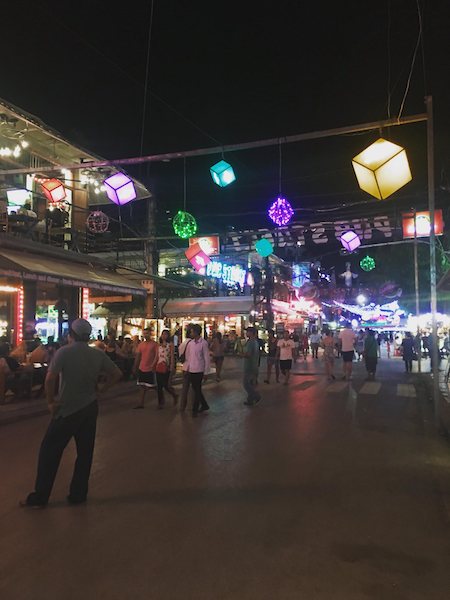
On Saturday morning, four us (all ODC interns) woke up before the crack of dawn and prepared for our big day. We had arranged for a tuk tuk driver to take us around the main temples, sometimes called “The Small Circuit,” including a sunrise trip to Angkor Wat itself. Fumbling through our exhaustion, we clamored into our tuk tuk, cloaked in the hush of pre-dawn darkness. Upon arrival, we found a steady stream of sleepy tourists already crossing the floating bridge that spans Angkor Wat’s rectangular moat. Following suit, we walked toward the temple, its iconic silhouette backlit and shadowed.
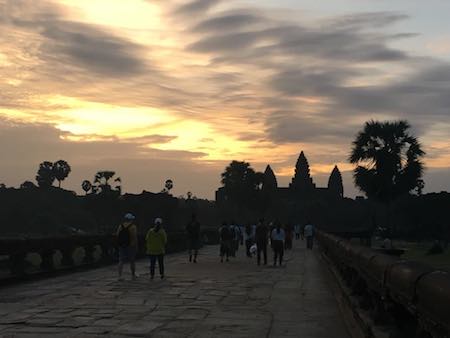
Everyone has probably seen pictures of the Famous Angkor Wat Sunrise, the sun rising behind the temple’s profile, reflected in a nearby pool. It is admittedly striking and a great “Nat Geo” shot. Of course, that means everyone and their dog is trying to take that exact same picture, congregating into a mass of tripods and foot-long lenses at the pool’s waterline. At first, our group contemplated joining the circus. However, I quickly surmised that, at 5”2” and wielding only a dinky phone camera, there was no way I could compete. Additionally, if all I wanted was a “Nat Geo” picture of the temple, I could just buy the magazine. Better yet, Google images could provide me with thousands of Angkor Sunrise photos for free. The only truly valuable picture of Angkor Wat, unavailable anywhere else on earth, was one with me in it, seeing the temple in the pale morning light and before the crowds swarmed.
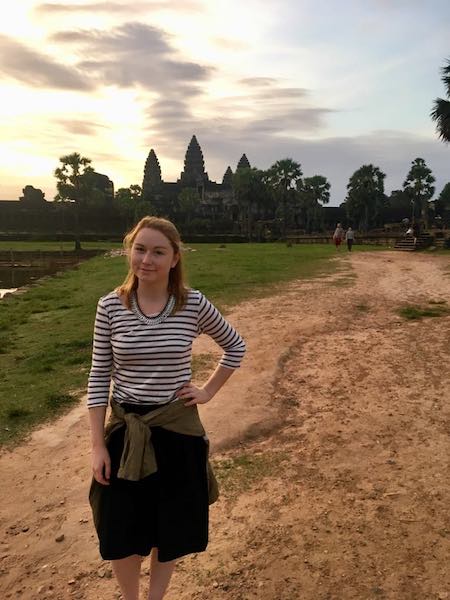
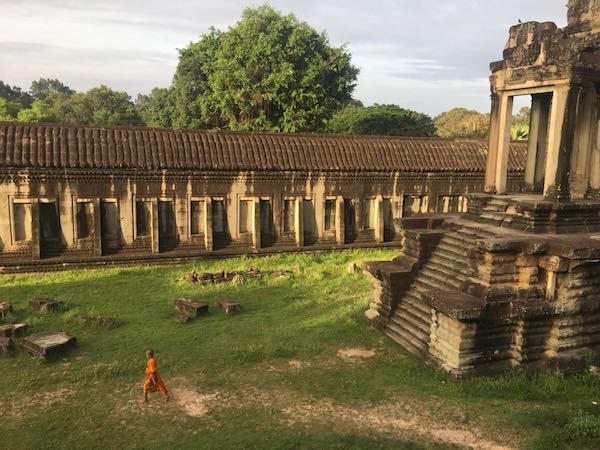
Angkor was spectacular at five am. Since most people were still outside waiting for the sun to fully rise, the temple was reasonably quiet, bathed in an orange glow. In a lot of ways, it was a better Angkor Sunrise experience than I expected. Our group was able to meander through the temple comfortably, taking time to sit and look out over the peripheral courtyards, framed by encroaching jungle, monkeys darting along the temple roofs. A few monks went about their daily business, their orange robes sharply contrasting Angkor’s grey sandstone. The temple itself is massive, and its shear stature is more impressive than anything else. However, Angkor Wat is also famous for its opulent bas-beliefs, which stretch the extended lengths of its outer walls. When we visited these carvings, the long corridors were borderline empty, leaving us ample time to regard the fantastically ornate reliefs.
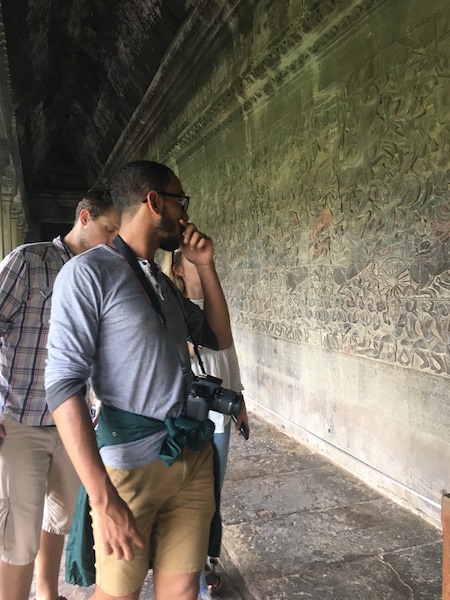
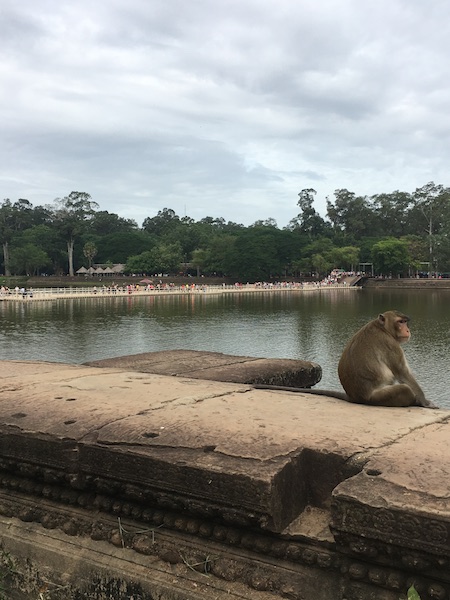
After seeing stunning Angkor Wat, our group proceeded to the next temple complex: Angkor Thom, a nine kilometer walled city built in the 12th century (coincidentally around the same time as Notre Dame in Paris, for perspective). Bayon, the city’s flagship temple, was particularly picturesque, with its hundreds of carved faces, all sporting wry, Mona Lisa smiles. It was perhaps here that I was first struck with how unreal the temples appeared. I had spent so much of my life seeing imitations (see: Disneyworld) and photo spreads in coffee table books that, when faced with the real thing, my brain just short-circuited.

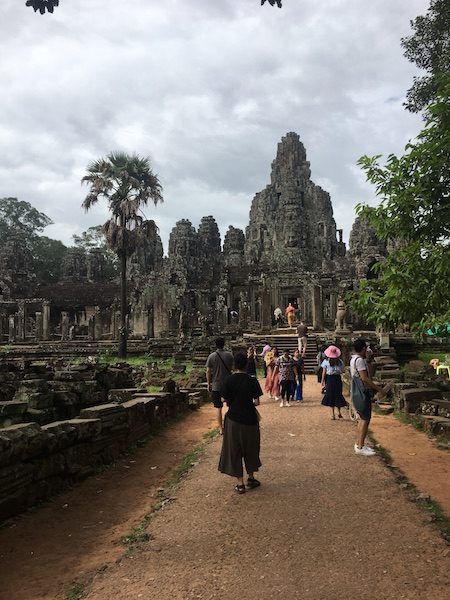
We continued to see more temples for the rest of the morning, the heat and humidity intensifying with each passing hour. Since we had gotten an early start, most of the temples had been quiet and relatively cool, at least by Cambodian standards. However, when we visited Ta Prohm, we collided with massive tour buses. Made recognizable by Angelina Jolie’s Tomb Raider, Ta Prohm is the quintessential overgrown jungle temple, with trees and roots growing into the temple’s crumbling walls. However, with the massive crowds, coupled with the temple’s narrow, caved-in passageways, Ta Prohm was cripplingly claustrophobic. Actual queues had formed for picture-taking in front of the more photogenic spots. It was all-around sort of unbearable and I could feel our group’s morale plummet. That said, our troupe of four had a good system. We would each dart forward in front of a photo-op and, in rapid succession, take photos of each other and cycle. Despite the mob, we managed to get most of our photos- and guess what! You can barely tell that there were fifty bazillion people just out of frame.
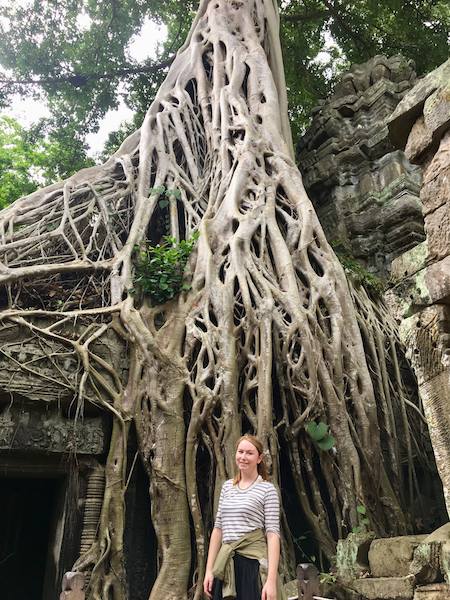
After Ta Prohm, however, our efforts seemed silly. Banteay Kdei ended up being nearly identical to Ta Prohm, with similarly majestic tree growths seeping into the stones and mossy alcoves. But without the all-important Tomb Raider brand, the temple was practically empty. While I am ultimately glad I saw Ta Prohm and experienced the tourist shuffle (and, I admit, I watched Tomb Raider a million times as a kid), I much more enjoyed its hipster cousin, Kdei.
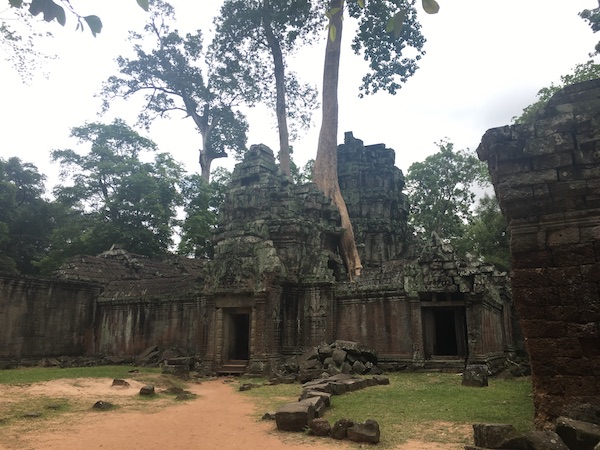
In the afternoon, I was wiped. After a quick Khmer lunch, I returned to the hotel and put on my bathing suit with every intention of relaxing by the pool. Of course, I never made it. As soon as I sat down on my bed, I was quits. For the next couple of hours, I slept like the dead, only groggily awaking for a fancy dinner with Jean and Daniel, a brief walk around Pub Street, and then back to sleep.
On Sunday, we each had our own plans and priorities. One of my friends got on a boat to Battambang, Alex chose to explore the city center more, Daniel slept in. Jean and I, however, awoke early once more for another long morning of temples. This time, however, we decided to travel relatively far from Siem Reap to see the satellite temples, apparently just as memorably as Angkor Wat and Bayon, but oft overlooked.
The tuk tuk ride to Banteay Srei took approximately one hour, but it was a refreshing drive. Multiple expats in my apartment building have raved about the quaintness of the Cambodian countryside, calling it a must-see. Since my commercial bus rides through Cambodia (like to Sihanoukville and Mondulkiri) never strayed far from the highway, I doubted I had actually seen this “Real Cambodia.” Crossing off another thing from my bucket list, I got to see legitimately pastoral Cambodia on the way to Banteay Srei. Further, I am happy to confirm it is just as delightful as everyone says, with all the classic wooden homes on stilts, children playing along the streets, and water buffalo mucking around in rice fields. At that point, I hardly cared if Srei lived up to the hype; I was already pleased with my Sunday excursion.
No worries though, Banteay Srei was absolutely worth it. The oldest temple we saw on our trip (10th century), its name roughly translates to “Citadel of Women,” so named because its carvings are believed to be too delicate to have been made by a man. Additionally, the diminutive temple is carved entirely out of rose-colored sandstone, meaning Banteay Srei is pink! I think this was my favorite of all the temples, though it seems unfair to select amongst such a collection of gems.
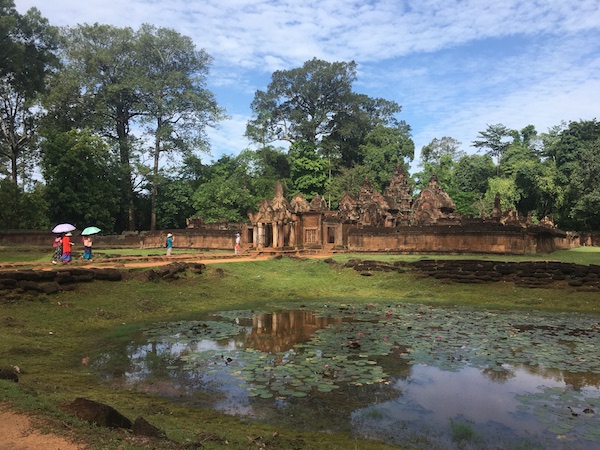
Our next remote temple was Banteay Samre. While not particularly outstanding in its architecture, carvings, or scale, Samre had one striking quality: it was empty. And I am not exaggerating. Samre was deserted. Words cannot describe how peaceful and surreal it was to meander through the ancient temple, only hearing your own footsteps and the rustle of wind. Jean and I even sat down on the temple steps for a while, reflecting on the stillness, whispering to each other sparingly.
After Samre, we went to a few more miscellaneous temples that are members of the “Big Circuit,” a popular Angkor itinerary the includes several heavy-hitter temples, though usually not as famous as those on the “Small Circuit.” Jean and I checked out Ta Som, which was even more overgrown and wild than Banteay Kdei. Ready to heady home, we asked our tuk tuk driver to drop us off on Pub Street for lunch. However, after we told him that we were leaving Siem Reap that afternoon, he made a special detour to ensure we saw Preah Khan, an absolutely massive temple said to have housed almost 100,000 officials and servants in its heyday.
While Preah Khan was neat, I was more touched by the easy rapport we had formed with our tuk tuk driver. With a friendly, round face, our group had become his biggest fans. After all, we had spent nearly all Saturday and Sunday with him, his smile greeting us warmly after we exited each temple. When Jean and I had pulled over to do a little souvenir shopping, he had even enthusiastically translated and haggled on our behalf. I just could not (and still cannot) get over that he took the effort to ensure we saw one last Angkor highlight, which we otherwise would have missed. In short, I continue to be inspired by the genuine kindness and good-will of nearly every Cambodian I meet.
On a different note, I was also struck by the maturations of the Angkor temples, which are still living and growing today. When originally built, every temple was Hindu, most of them dedicated to Shiva or Vishnu. Over time, they were converted to a Buddhist purpose, and you can still see where someone has roughly chiseled away the Hindu dedications. Today, the Angkor temples are a tourist attraction, more prized for their archaeological value than anything else. However, in each temple there is still a Buddhist shrine, or several, with devotees actively lighting incense and meditating- even as throngs of tourist stream past. It was bizarre, but unsurprising I suppose, watching these two groups, the secular and the religious, ignore each other with raw indifference. I felt, in many ways, like I was watching two ships glide past each other in the night, yet still tenuously connected by a deep admiration for the temples themselves.

My trip to Siem Reap and Angkor Wat was as fascinating and fun as it was exhausting. For several days after I returned to Phnom Penh, I could not stop looking over my photos, which already feel too picture-perfect to be real. On another note, I also cannot walk up multiple flights of stairs without wincing from fatigue. Ultimately, I am looking forward to my upcoming weekend of relaxation and rest in Phnom Penh.